编译原理实验报告《LL(1)语法分析器构造》
编译原理实验报告《ll(1)语法分析器构造》
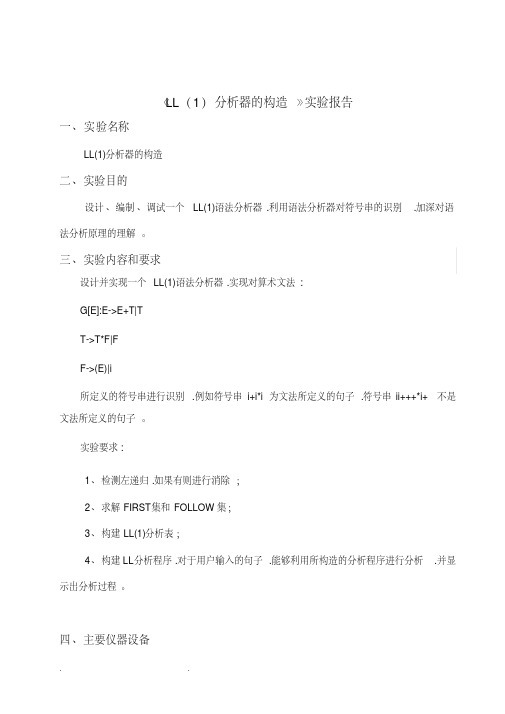
规则右部首符号是终结
符
.
.
{ first[r].append(1,a); break;// 添加并结束
}
if(U.find(P[i][j])!=string::npos)// 规则右部首符号是非终结符 ,形如 X:: =Y1Y2...Yk
{
s=U.find(P[i][ j]);
//cout<<P[i][ j]<<":\n";
arfa=beta=""; for( j=0;j<100&&P[j][0]!=' ';j++) {
if(P[ j][0]==U[i]) {
if(P[ j][4]==U[i])// 产生式 j 有左递归 {
flagg=1;
.
.
for(temp=5;P[j][temp]!=' ';temp++) arfa.append(1,P[
{
int i,j,r,s,tmp;
string* first=new string[n];
char a;
int step=100;// 最大推导步数
while(step--){
// cout<<"step"<<100-step<<endl;
for(i=0;i<k;i++)
{
//cout<<P[i]<<endl;
j][temp]);
if(P[ j+1][4]==U[i]) arfa.append("|");//
编译原理实验二LL(1)语法分析实验报告
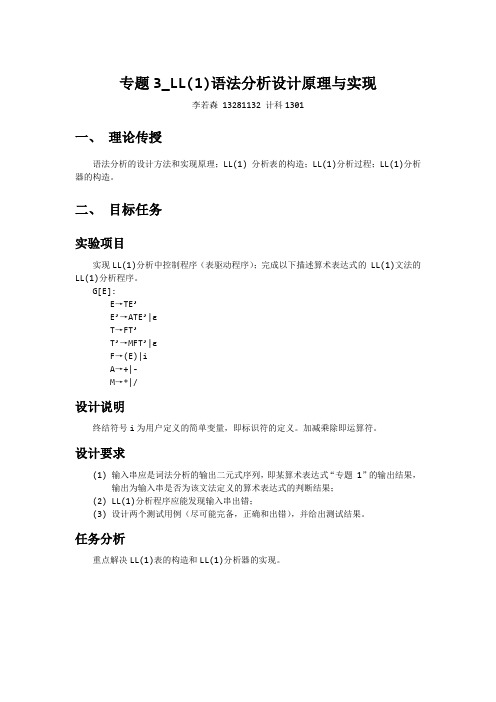
专题3_LL(1)语法分析设计原理与实现李若森 13281132 计科1301一、理论传授语法分析的设计方法和实现原理;LL(1) 分析表的构造;LL(1)分析过程;LL(1)分析器的构造。
二、目标任务实验项目实现LL(1)分析中控制程序(表驱动程序);完成以下描述算术表达式的 LL(1)文法的LL(1)分析程序。
G[E]:E→TE’E’→ATE’|εT→FT’T’→MFT’|εF→(E)|iA→+|-M→*|/设计说明终结符号i为用户定义的简单变量,即标识符的定义。
加减乘除即运算符。
设计要求(1)输入串应是词法分析的输出二元式序列,即某算术表达式“专题 1”的输出结果,输出为输入串是否为该文法定义的算术表达式的判断结果;(2)LL(1)分析程序应能发现输入串出错;(3)设计两个测试用例(尽可能完备,正确和出错),并给出测试结果。
任务分析重点解决LL(1)表的构造和LL(1)分析器的实现。
三、实现过程实现LL(1)分析器a)将#号放在输入串S的尾部b)S中字符顺序入栈c)反复执行c),任何时候按栈顶Xm和输入ai依据分析表,执行下述三个动作之一。
构造LL(1)分析表构造LL(1)分析表需要得到文法G[E]的FIRST集和FOLLOW集。
构造FIRST(α)构造FOLLOW(A)构造LL(1)分析表算法根据上述算法可得G[E]的LL(1)分析表,如表3-1所示:表3-1 LL(1)分析表主要数据结构pair<int, string>:用pair<int, string>来存储单个二元组。
该对照表由专题1定义。
map<string, int>:存储离散化后的终结符和非终结符。
vector<string>[][]:存储LL(1)分析表函数定义init:void init();功能:初始化LL(1)分析表,关键字及识别码对照表,离散化(非)终结符传入参数:(无)传出参数:(无)返回值:(无)Parse:bool Parse( const vector<PIS> &vec, int &ncol );功能:进行该行的语法分析传入参数:vec:该行二元式序列传出参数:emsg:出错信息epos:出错标识符首字符所在位置返回值:是否成功解析。
编译原理语法分析器实验报告

编译原理语法分析器实验报告班级:学号:姓名:实验名称语法分析器一、实验目的1、根据某一文法编制调试LL(1)分析程序,以便对任意输入的符号串进行分析。
2、本次实验的目的主要是加深对自上而下分析法的理解。
二、实验内容[问题描述]递归下降分析法:0.定义部分:定义常量、变量、数据结构。
1.初始化:从文件将输入符号串输入到字符缓冲区中。
2.利用递归下降分析法分析,对每个非终结符编写函数,在主函数中调用文法开始符号的函数。
LL(1)分析法:模块结构:1、定义部分:定义常量、变量、数据结构。
2、初始化:设立LL(1)分析表、初始化变量空间(包括堆栈、结构体等);3、运行程序:让程序分析一个text文件,判断输入的字符串是否符合文法定义的规则;4、利用LL(1)分析算法进行表达式处理:根据LL(1)分析表对表达式符号串进行堆栈(或其他)操作,输出分析结果,如果遇到错误则显示简单的错误提示。
[基本要求]1. 对数据输入读取2. 格式化输出分析结果2.简单的程序实现词法分析public static void main(String args[]) {LL l = new LL();l.setP();String input = "";boolean flag = true;while (flag) {try {InputStreamReader isr = newInputStreamReader(System.in);BufferedReader br = new BufferedReader(isr);System.out.println();System.out.print("请输入字符串(输入exit退出):");input = br.readLine();} catch (Exception e) {e.printStackTrace();}if(input.equals("exit")){flag = false;}else{l.setInputString(input);l.setCount(1, 1, 0, 0);l.setFenxi();System.out.println();System.out.println("分析过程");System.out.println("----------------------------------------------------------------------");System.out.println(" 步骤| 分析栈| 剩余输入串| 所用产生式");System.out.println("----------------------------------------------------------------------");boolean b = l.judge();System.out.println("----------------------------------------------------------------------");if(b){System.out.println("您输入的字符串"+input+"是该文法的一个句子");}else{System.out.println("您输入的字符串"+input+"有词法错误!");}}}}//实现各函数并且加注释三、编程并上机调试运行运行结果如下图:四、实验小结通过这次实验,我对语法分析有了更深刻的了解,对它的形成有了更清楚得认识。
编译原理实验二语法分析器LL(1)实现

编译原理程序设计实验报告——表达式语法分析器的设计班级:计算机1306班:涛学号:20133967 实验目标:用LL(1)分析法设计实现表达式语法分析器实验容:⑴概要设计:通过对实验一的此法分析器的程序稍加改造,使其能够输出正确的表达式的token序列。
然后利用LL(1)分析法实现语法分析。
⑵数据结构:int op=0; //当前判断进度char ch; //当前字符char nowword[10]=""; //当前单词char operate[4]={'+','-','*','/'}; //运算符char bound[2]={'(',')'}; //界符struct Token{int code;char ch[10];}; //Token定义struct Token tokenlist[50]; //Token数组struct Token tokentemp; //临时Token变量struct Stack //分析栈定义{char *base;char *top;int stacksize;};⑶分析表及流程图逆序压栈int IsLetter(char ch) //判断ch是否为字母int IsDigit(char ch) //判断ch是否为数字int Iskey(char *string) //判断是否为关键字int Isbound(char ch) //判断是否为界符int Isboundnum(char ch) //给出界符所在token值int init(STack *s) //栈初始化int pop(STack *s,char *ch) //弹栈操作int push(STack *s,char ch) //压栈操作void LL1(); //分析函数源程序代码:(加入注释)#include<stdio.h>#include<string.h>#include<ctype.h>#include<windows.h>#include <stdlib.h>int op=0; //当前判断进度char ch; //当前字符char nowword[10]=""; //当前单词char operate[4]={'+','-','*','/'}; //运算符char bound[2]={'(',')'}; //界符struct Token{int code;char ch[10];}; //Token定义struct Token tokenlist[50]; //Token数组struct Token tokentemp; //临时Token变量struct Stack //分析栈定义{char *base;char *top;int stacksize;};typedef struct Stack STack;int init(STack *s) //栈初始化{(*s).base=(char*)malloc(100*sizeof(char)); if(!(*s).base)exit(0);(*s).top=(*s).base;(*s).stacksize=100;printf("初始化栈\n");return 0;}int pop(STack *s,char *ch) //弹栈操作{if((*s).top==(*s).base){printf("弹栈失败\n");return 0;(*s).top--;*ch=*((*s).top);printf("%c",*ch);return 1;}int push(STack *s,char ch) //压栈操作{if((*s).top-(*s).base>=(*s).stacksize){(*s).base=(char*)realloc((*s).base,((*s).stacksize+10)*sizeof(char)); if(!(*s).base)exit(0);(*s).top=(*s).base+(*s).stacksize;(*s).stacksize+=10;}*(*s).top=ch;*(*s).top++;return 1;}void LL1();int IsLetter(char ch) //判断ch是否为字母{int i;for(i=0;i<=45;i++)if ((ch>='a'&&ch<='z')||(ch>='A'&&ch<='Z'))return 1;return 0;}int IsDigit(char ch) //判断ch是否为数字{int i;for(i=0;i<=10;i++)if (ch>='0'&&ch<='9')return 1;return 0;}int Isbound(char ch) //判断是否为界符{int i;for(i=0;i<2;i++)if(ch==bound[i]){return i+1;}}return 0;}int Isoperate(char ch) //判断是否为运算符{int i;for(i=0;i<4;i++){if(ch==operate[i]){return i+3;}}return 0;}int main(){FILE *fp;int q=0,m=0;char sour[200]=" ";printf("请将源文件置于以下位置并按以下方式命名:F:\\2.txt\n");if((fp=fopen("F:\\2.txt","r"))==NULL){printf("文件未找到!\n");}else{while(!feof(fp)){if(isspace(ch=fgetc(fp)));else{sour[q]=ch;q++;}}}int p=0;printf("输入句子为:\n");for(p;p<=q;p++)printf("%c",sour[p]);}printf("\n");int state=0,nowlen=0;BOOLEAN OK=TRUE,ERR=FALSE;int i,flagpoint=0;for(i=0;i<q;i++){if(sour[i]=='#')tokenlist[m].code=='#';switch(state){case 0:ch=sour[i];if(Isbound(ch)){if(ERR){printf("无法识别\n");ERR=FALSE;OK=TRUE;}else if(!OK){printf("<10,%s>标识符\n",nowword); tokentemp.code=10;tokentemp.ch[10]=nowword[10];tokenlist[m]=tokentemp;m++;OK=TRUE;}state=4;}else if(IsDigit(ch)){if(OK){memset(nowword,0,strlen(nowword)); nowlen=0;nowword[nowlen]=ch;nowlen++;state=3;OK=FALSE;break;}else{nowword[nowlen]=ch;nowlen++;}}else if(IsLetter(ch)){if(OK){memset(nowword,0,strlen(nowword));nowlen=0;nowword[nowlen]=ch;nowlen++;OK=FALSE;}else{nowword[nowlen]=ch;nowlen++;}}else if(Isoperate(ch)){if(!OK){printf("<10,%s>标识符\n",nowword);tokentemp.code=10;tokentemp.ch[10]=nowword[10];tokenlist[m]=tokentemp;m++;OK=TRUE;}printf("<%d,%c>运算符\n",Isoperate(ch),ch); tokentemp.code=Isoperate(ch);tokentemp.ch[10]=ch;tokenlist[m]=tokentemp;m++;}break;case 3:if(IsLetter(ch)){printf("错误\n");nowword[nowlen]=ch;nowlen++;ERR=FALSE;state=0;break;}if(IsDigit(ch=sour[i])){nowword[nowlen]=ch;nowlen++;}else if(sour[i]=='.'&&flagpoint==0){flagpoint=1;nowword[nowlen]=ch;nowlen++;}else{printf("<20,%s>数字\n",nowword);i--;state=0;OK=TRUE;tokentemp.code=20;tokentemp.ch[10]=nowword[10];tokenlist[m]=tokentemp;m++;}break;case 4:i--;printf("<%d,%c>界符\n",Isbound(ch),ch); tokentemp.code=Isbound(ch);tokentemp.ch[10]=ch;tokenlist[m]=tokentemp;m++;state=0;OK=TRUE;break;}}printf("tokenlist值为%d\n",m);int t=0;tokenlist[m+1].code='r';m++;for(t;t<m;t++){printf("tokenlist%d值为%d\n",t,tokenlist[t].code);}LL1();printf("tokenlist值为%d\n",m);if(op+1==m)printf("OK!!!");elseprintf("WRONG!!!");return 0;}void LL1(){STack s;init(&s);push(&s,'#');push(&s,'E');char ch;int flag=1;do{pop(&s,&ch);printf("输出栈顶为%c\n",ch);printf("输出栈顶为%d\n",ch);printf("当前p值为%d\n",op);if((ch=='(')||(ch==')')||(ch=='+')||(ch=='-')||(ch=='*')||(ch=='/')||(ch==10)||(ch==20)) {if(tokenlist[op].code==1||tokenlist[op].code==20||tokenlist[op].code==10||tokenlist[op].cod e==2||tokenlist[op].code==3||tokenlist[op].code==4||tokenlist[op].code==5||tokenlist[op].co de==6)op++;else{printf("WRONG!!!");exit(0);}}else if(ch=='#'){if(tokenlist[op].code==0)flag=0;else{printf("WRONG!!!");exit(0);}}else if(ch=='E'){printf("进入E\n");if(tokenlist[op].code==10||tokenlist[op].code==20||tokenlist[op].code==1) {push(&s,'R');printf("将R压入栈\n");push(&s,'T');}}else if(ch=='R'){printf("进入R\n");if(tokenlist[op].code==3||tokenlist[op].code==4){push(&s,'R');push(&s,'T');printf("将T压入栈\n");push(&s,'+');}if(tokenlist[op].code==2||tokenlist[op].code==0){}}else if(ch=='T'){printf("进入T\n");if(tokenlist[op].code==10||tokenlist[op].code==20||tokenlist[op].code==1) {push(&s,'Y');push(&s,'F');}}else if(ch=='Y'){printf("进入Y\n");if(tokenlist[op].code==5||tokenlist[op].code==6){push(&s,'Y');push(&s,'F');push(&s,'*');}elseif(tokenlist[op].code==3||tokenlist[op].code==2||tokenlist[op].code==0||tokenlist[op].code= =4){}}else if(ch=='F'){printf("进入F\n");if(tokenlist[op].code==10||tokenlist[op].code==20){push(&s,10);}if(tokenlist[op].code==1){push(&s,')');push(&s,'E');push(&s,'(');}}else{printf("WRONG!!!!");exit(0);}}while(flag);}程序运行结果:(截屏)输入:((Aa+Bb)*(88.2/3))#注:如需运行请将文件放置F盘,并命名为:2.txt输出:思考问题回答:LL(1)分析法的主要问题就是要正确的将文法化为LL (1)文法。
编译原理-实验3-LL(1)分析文法构造
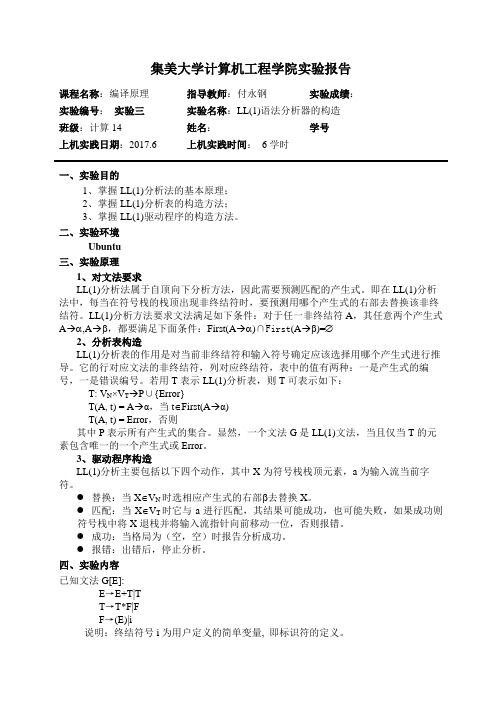
集美大学计算机工程学院实验报告课程名称:编译原理指导教师:付永钢实验成绩:实验编号:实验三实验名称:LL(1)语法分析器的构造班级:计算14姓名:学号上机实践日期:2017.6上机实践时间:6学时一、实验目的1、掌握LL(1)分析法的基本原理;2、掌握LL(1)分析表的构造方法;3、掌握LL(1)驱动程序的构造方法。
二、实验环境Ubuntu三、实验原理1、对文法要求LL(1)分析法属于自顶向下分析方法,因此需要预测匹配的产生式。
即在LL(1)分析法中,每当在符号栈的栈顶出现非终结符时,要预测用哪个产生式的右部去替换该非终结符。
LL(1)分析方法要求文法满足如下条件:对于任一非终结符A,其任意两个产生式A→α,A→β,都要满足下面条件:First(A→α)∩First(A→β)=∅2、分析表构造LL(1)分析表的作用是对当前非终结符和输入符号确定应该选择用哪个产生式进行推导。
它的行对应文法的非终结符,列对应终结符,表中的值有两种:一是产生式的编号,一是错误编号。
若用T表示LL(1)分析表,则T可表示如下:T: V N×V T→P∪{Error}T(A, t) = A→α,当t∈First(A→α)T(A, t) = Error,否则其中P表示所有产生式的集合。
显然,一个文法G是LL(1)文法,当且仅当T的元素包含唯一的一个产生式或Error。
3、驱动程序构造LL(1)分析主要包括以下四个动作,其中X为符号栈栈顶元素,a为输入流当前字符。
●替换:当X∈V N时选相应产生式的右部β去替换X。
●匹配:当X∈V T时它与a进行匹配,其结果可能成功,也可能失败,如果成功则符号栈中将X退栈并将输入流指针向前移动一位,否则报错。
●成功:当格局为(空,空)时报告分析成功。
●报错:出错后,停止分析。
四、实验内容已知文法G[E]:E→E+T|TT→T*F|FF→(E)|i说明:终结符号i为用户定义的简单变量, 即标识符的定义。
编译原理LL(1)语法分析实验报告
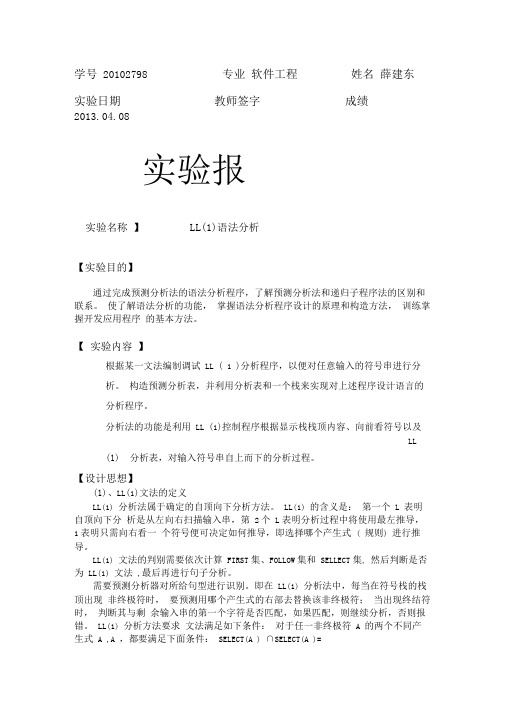
实验报实验名称 】 LL (1)语法分析【实验目的】通过完成预测分析法的语法分析程序,了解预测分析法和递归子程序法的区别和联系。
使了解语法分析的功能, 掌握语法分析程序设计的原理和构造方法, 训练掌握开发应用程序 的基本方法。
【 实验内容 】根据某一文法编制调试 LL ( 1 )分析程序,以便对任意输入的符号串进行分析。
构造预测分析表,并利用分析表和一个栈来实现对上述程序设计语言的分析程序。
分析法的功能是利用 LL (1)控制程序根据显示栈栈顶内容、向前看符号以及 LL(1) 分析表,对输入符号串自上而下的分析过程。
【设计思想】(1) 、LL (1)文法的定义LL(1) 分析法属于确定的自顶向下分析方法。
LL(1) 的含义是: 第一个 L 表明自顶向下分 析是从左向右扫描输入串,第 2个 L 表明分析过程中将使用最左推导, 1表明只需向右看一 个符号便可决定如何推导,即选择哪个产生式 ( 规则) 进行推导。
LL(1) 文法的判别需要依次计算 FIRST 集、FOLLOW 集和 SELLECT 集, 然后判断是否为 LL(1) 文法 ,最后再进行句子分析。
需要预测分析器对所给句型进行识别。
即在 LL(1) 分析法中,每当在符号栈的栈顶出现 非终极符时, 要预测用哪个产生式的右部去替换该非终极符; 当出现终结符时, 判断其与剩 余输入串的第一个字符是否匹配,如果匹配,则继续分析,否则报错。
LL(1) 分析方法要求 文法满足如下条件: 对于任一非终极符 A 的两个不同产生式 A ,A ,都要满足下面条件: SELECT(A ) ∩SELECT(A )=学号 20102798 实验日期 2013.04.08专业 软件工程 教师签字 姓名 薛建东 成绩( 2)、预测分析表构造LL(1) 分析表的作用是对当前非终极符和输入符号确定应该选择用哪个产生式进行推导。
它的行对应文法的非终极符,列对应终极符,表中的值有两种:一是产生式的右部的字符串,一是null 。
编译原理语法分析器实验报告
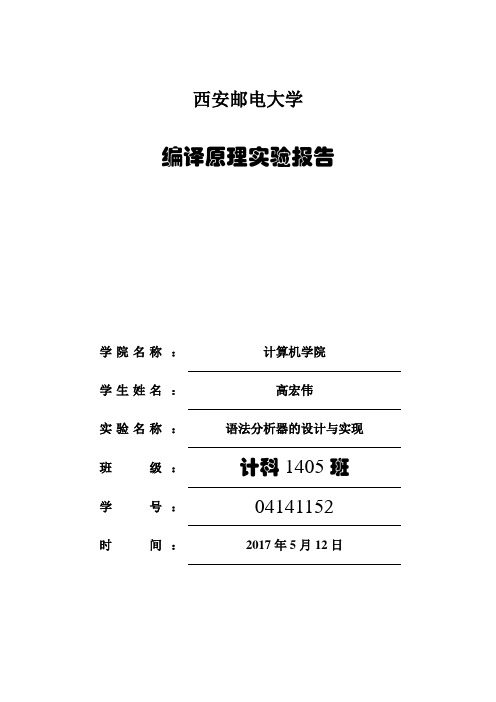
西安邮电大学编译原理实验报告学院名称:计算机学院****:***实验名称:语法分析器的设计与实现班级:计科1405班学号:04141152时间:2017年5月12日一.实验目的1.熟悉语法分析的过程2.理解相关文法分析的步骤3.熟悉First集和Follow集的生成二.实验要求对于给定的文法,试编写调试一个语法分析程序:要求和提示:1)可选择一种你感兴趣的语法分析方法(LL(1)、算符优先、递归下降、SLR(1)等)作为编制语法分析程序的依据。
2)对于所选定的分析方法,如有需要,应选择一种合适的数据结构,以构造所给文法的机内表示。
3)能进行分析过程模拟。
如输入一个句子,能输出与句子对应的语法树,能对语法树生成过程进行模拟;能够输出分析过程每一步符号栈的变化情况。
设计一个由给定文法生成First集和Follow集并进行简化的算法动态模拟三.实验内容1.文法:E->TE’E’->+TE’|εT->FT’T’->*FT’|εF->(E)|i:2.程序描述(LL(1)文法)本程序是基于已构建好的某一个语法的预测分析表来对用户的输入字符串进行分析,判断输入的字符串是否属于该文法的句子。
基本实现思想:接收用户输入的字符串(字符串以“#”表示结束)后,对用做分析栈的一维数组和存放分析表的二维数组进行初始化。
然后取出分析栈的栈顶字符,判断是否为终结符,若为终结符则判断是否为“#”且与当前输入符号一样,若是则语法分析结束,输入的字符串为文法的一个句子,否则出错若不为“#”且与当前输入符号一样则将栈顶符号出栈,当前输入符号从输入字符串中除去,进入下一个字符的分析。
若不为“#”且不与当前输入符号一样,则出错。
3.判断是否LL(1)文法要判断是否为LL(1)文法,需要输入的文法G有如下要求:具有相同左部的规则的SELECT集两两不相交,即:SELECT(A→?)∩SELECT(A→?)= ?如果输入的文法都符合以上的要求,则该文法可以用LL(1)方法分析。
编译原理LL(1)分析实验报告
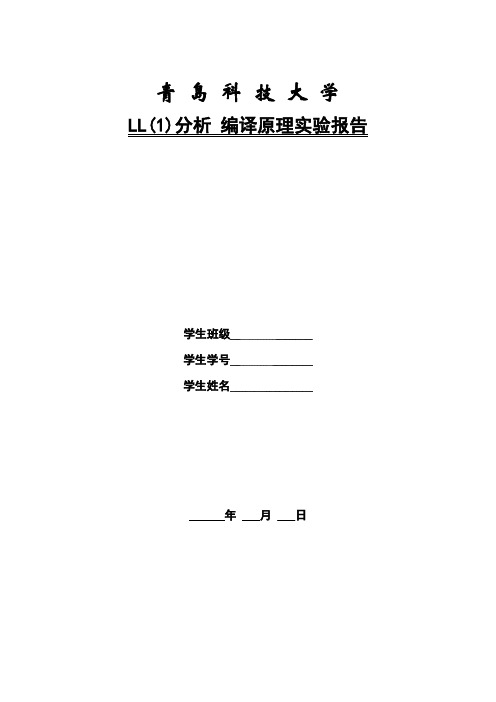
青岛科技大学LL(1)分析编译原理实验报告学生班级__________________________学生学号__________________________学生姓名________________________________年 ___月 ___日一、实验目的LL(1)分析法的基本思想是:自项向下分析时从左向右扫描输入串,分析过程中将采用最左推导,并且只需向右看一个符号就可决定如何推导。
通过对给定的文法构造预测分析表和实现某个符号串的分析,掌握LL(1)分析法的基本思想和实现过程。
二、实验要求设计一个给定的LL(1)分析表,输入一个句子,能根据LL(1)分析表输出与句子相应的语法数。
能对语法数生成过程进行模拟。
三、实验内容(1)给定表达式文法为:G(E’): E’→#E# E→E+T | T T→T*F |F F→(E)|i(2)分析的句子为:(i+i)*i四、模块流程五、程序代码#include<iostream>#include<stdio.h>#include <string>#include <stack>using namespace std;char Vt[]={'i','+','*','(',')','#'}; /*终结符*/char Vn[]={'E','e','T','t','F'}; /*非终结符*/ int LENVt=sizeof(Vt);void showstack(stack <char> st) //从栈底开始显示栈中的内容{int i,j;char ch[100];j=st.size();for(i=0;i<j;i++){ch[i]=st.top();st.pop();}for(i=j-1;i>=0;i--){cout<<ch[i];st.push(ch[i]);}}int find(char c,char array[],int n) //查找函数,返回布尔值{int i;int flag=0;for(i=0;i<n;i++){if(c==array[i])flag=1;}return flag;}int location(char c,char array[]) //定位函数,指出字符所在位置,即将字母转换为数组下标值{int i;for(i=0;c!=array[i];i++);return i;}void error(){cout<<" 出错!"<<endl;}void analyse(char Vn[],char Vt[],string M[5][6],string str){int i,j,p,q,h,flag=1;char a,X;stack <char> st; //定义堆栈st.push('#');st.push(Vn[0]); //#与识别符号入栈j=0; //j指向输入串的指针h=1;a=str[j];cout<<"步骤"<<"分析栈"<<"剩余输入串"<<" 所用产生式"<<endl;while(flag==1){cout<<h<<" "; //显示步骤h++;showstack(st); //显示分析栈中内容cout<<" ";for(i=j;i<str.size();i++) cout<<str[i]; //显示剩余字符串X=st.top(); //取栈顶符号放入X if(find(X,Vt,LENVt)==1) //X是终结符if(X==a) //分析栈的栈顶元素和剩余输入串的第一个元素相比较if (X!='#'){cout<<" "<<X<<"匹配"<<endl;st.pop();a=str[++j]; //读入输入串的下一字符}else{ cout<<" "<<"acc!"<<endl<<endl; flag=0;}else{error();break;}else{p=location(X,Vn); //实现下标的转换(非终结符转换为行下标)q=location(a,Vt); //实现下标的转换(终结符转换为列下标)string S1("NULL"),S2("null");if(M[p][q]==S1 || M[p][q]==S2) //查找二维数组中的产生式{error();break;} //对应项为空,则出错else{string str0=M[p][q];cout<<" "<<X<<"-->"<<str0<<endl; //显示对应的产生式st.pop();if(str0!="$") //$代表"空"字符for(i=str0.size()-1;i>=0;i--) st.push(str0[i]);//产生式右端逆序进栈}}}}main(){string M[5][6]={"Te" ,"NULL","NULL","Te", "NULL","NULL","NULL","+Te" ,"NULL","NULL","$", "$","Ft", "NULL","NULL","Ft", "NULL","NULL","NULL","$", "*Ft", "NULL","$", "$","i", "NULL","NULL","(E)", "NULL","NULL"}; //预测分析表j string str;int errflag,i;cout<<"文法:E->E+T|T T->T*F|F F->(E)|i"<<endl;cout<<"请输入分析串(以#结束):"<<endl;do{ errflag=0;cin>>str;for(i=0;i<str.size();i++)if(!find(str[i],Vt,LENVt)){ cout<<"输入串中包含有非终结符"<<str[i]<<"(输入错误)!"<<endl;errflag=1;}} while(errflag==1); //判断输入串的合法性analyse(Vn, Vt, M,str);return 0;}六、实验结果七、实验总结。
编译原理实验二:LL(1)语法分析器

编译原理实验⼆:LL(1)语法分析器⼀、实验要求 1. 提取左公因⼦或消除左递归(实现了消除左递归) 2. 递归求First集和Follow集 其它的只要按照课本上的步骤顺序写下来就好(但是代码量超多...),下⾯我贴出实验的⼀些关键代码和算法思想。
⼆、基于预测分析表法的语法分析 2.1 代码结构 2.1.1 Grammar类 功能:主要⽤来处理输⼊的⽂法,包括将⽂法中的终结符和⾮终结符分别存储,检测直接左递归和左公因⼦,消除直接左递归,获得所有⾮终结符的First集,Follow集以及产⽣式的Select集。
#ifndef GRAMMAR_H#define GRAMMAR_H#include <string>#include <cstring>#include <iostream>#include <vector>#include <set>#include <iomanip>#include <algorithm>using namespace std;const int maxn = 110;//产⽣式结构体struct EXP{char left; //左部string right; //右部};class Grammar{public:Grammar(); //构造函数bool isNotTer(char x); //判断是否是终结符int getTer(char x); //获取终结符下标int getNonTer(char x); //获取⾮终结符下标void getFirst(char x); //获取某个⾮终结符的First集void getFollow(char x); //获取某个⾮终结符的Follow集void getSelect(char x); //获取产⽣式的Select集void input(); //输⼊⽂法void scanExp(); //扫描输⼊的产⽣式,检测是否有左递归和左公因⼦void remove(); //消除左递归void solve(); //处理⽂法,获得所有First集,Follow集以及Select集void display(); //打印First集,Follow集,Select集void debug(); //⽤于debug的函数~Grammar(); //析构函数protected:int cnt; //产⽣式数⽬EXP exp[maxn]; //产⽣式集合set<char> First[maxn]; //First集set<char> Follow[maxn]; //Follow集set<char> Select[maxn]; //select集vector<char> ter_copy; //去掉$的终结符vector<char> ter; //终结符vector<char> not_ter; //⾮终结符};#endif 2.1.2 AnalyzTable类 功能:得到预测分析表,判断输⼊的⽂法是否是LL(1)⽂法,⽤预测分析表法判断输⼊的符号串是否符合刚才输⼊的⽂法,并打印出分析过程。
LL(1)语法分析器实验总报告书

LL(1)语法分析器实验报告书小组负责人:潘豪 SWE08030小组成员:邹杰光 SWE08018叶凯翔 SWE08039张志峰 SWE08046许英俊 SWE08062厦门大学嘉庚学院计算机系软件工程班课程小组2010年7月目录第一章概述 (3)1.1 开发平台 (3)1.2 实验目的 (3)1.3 实验要求 (3)第二章语法分析器的实现 (3)2.1 LL(1)语法分析器原理 (3)2.2 求出能推出空的终结符 (4)2.3 FIRST集的确定 (4)2.4 FOLLOW集的确定 (4)2.5 SELECT集的确定 (4)2.6 LL(1)文法的判别 (4)2.7 逻辑结构 (4)2.8 预测分析表的生成 (5)2.9 句子的判定 (5)2.10 其他说明 (5)第三章系统运行与测试 (6)3.1 程序运行环境 (6)3.2 运行界面 (6)3.3 系统测试 (8)第四章总述 (11)4.1 程序综述 (11)4.2小组工作总结 (11)第一章概述1.1 开发平台本程序基于Microsoft Visual Studio 2008开发,使用C#语言。
1.2 实验目的掌握LL(1)分析法的基本原理,掌握LL(1)分析表的构造方法,掌握LL(1)驱动程序的构造方法。
1.3 实验要求编写一个语法分析器,不限语言,方法。
第二章语法分析器的实现2.1 LL(1)语法分析器原理语法分析是编译过程的核心部分,它的主要任务是按照程序的语法规则,从由词法分析输出的源程序符号串中识别出各类语法成分,同时进行词法检查,为语义分析和代码生成作准备。
这里采用自顶向下的LL(1)分析方法。
语法分析程序的流程图如图5-4所示。
语法分析程序流程图2.2 求出能推出空的终结符见许英俊报告2.3 FIRST集的确定见邹杰光报告2.4 FOLLOW集的确定见张志峰报告2.5 SELECT集的确定见叶凯翔报告2.6 LL(1)文法的判别见叶凯翔报告2.7 逻辑结构一个LL(1)分析器由一张分析表、一个分析栈和一个总控程序组成。
编译原理语法分析实验报告

编译原理语法分析实验报告一、实验目的本实验主要目的是学习和掌握编译原理中的语法分析方法,通过实验了解和实践LR(1)分析器的实现过程,并对比不同的文法对语法分析的影响。
二、实验内容1.实现一个LR(1)的语法分析器2.使用不同的文法进行语法分析3.对比不同文法对语法分析的影响三、实验原理1.背景知识LR(1)分析器是一种自底向上(bottom-up)的语法分析方法。
它使用一个分析栈(stack)和一个输入缓冲区(input buffer)来处理输入文本,并通过移进(shift)和规约(reduce)操作进行语法分析。
2.实验步骤1)构建文法的LR(1)分析表2)读取输入文本3)初始化分析栈和输入缓冲区4)根据分析表进行移进或规约操作,直至分析过程结束四、实验过程与结果1.实验环境本实验使用Python语言进行实现,使用了语法分析库ply来辅助实验。
2.实验步骤1)构建文法的LR(1)分析表通过给定的文法,根据LR(1)分析表的构造算法,构建出分析表。
2)实现LR(1)分析器使用Python语言实现LR(1)分析器,包括读取输入文本、初始化分析栈和输入缓冲区、根据分析表进行移进或规约操作等功能。
3)使用不同的文法进行语法分析选择不同的文法对编写的LR(1)分析器进行测试,观察语法分析的结果。
3.实验结果通过不同的测试案例,实验结果表明编写的LR(1)分析器能够正确地进行语法分析,能够识别出输入文本是否符合给定文法。
五、实验分析与总结1.实验分析本实验通过实现LR(1)分析器,对不同文法进行语法分析,通过实验结果可以观察到不同文法对语法分析的影响。
2.实验总结本实验主要学习和掌握了编译原理中的语法分析方法,了解了LR(1)分析器的实现过程,并通过实验提高了对语法分析的理解。
六、实验心得通过本次实验,我深入学习了编译原理中的语法分析方法,了解了LR(1)分析器的实现过程。
在实验过程中,我遇到了一些问题,但通过查阅资料和请教老师,最终解决了问题,并完成了实验。
LL(1)语法分析实验报告
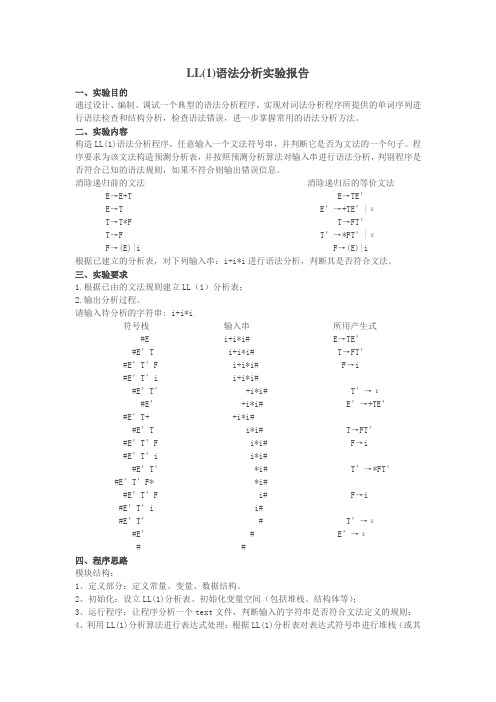
LL(1)语法分析实验报告一、实验目的通过设计、编制、调试一个典型的语法分析程序,实现对词法分析程序所提供的单词序列进行语法检查和结构分析,检查语法错误,进一步掌握常用的语法分析方法。
二、实验内容构造LL(1)语法分析程序,任意输入一个文法符号串,并判断它是否为文法的一个句子。
程序要求为该文法构造预测分析表,并按照预测分析算法对输入串进行语法分析,判别程序是否符合已知的语法规则,如果不符合则输出错误信息。
消除递归前的文法消除递归后的等价文法E→E+T E→TE’E→T E’→+TE’|εT→T*F T→FT’T→F T’→*FT’|εF→(E)|i F→(E)|i根据已建立的分析表,对下列输入串:i+i*i进行语法分析,判断其是否符合文法。
三、实验要求1.根据已由的文法规则建立LL(1)分析表;2.输出分析过程。
请输入待分析的字符串: i+i*i符号栈输入串所用产生式#E i+i*i# E→TE’#E’T i+i*i# T→FT’#E’T’F i+i*i# F→i#E’T’i i+i*i##E’T’ +i*i# T’→ε#E’ +i*i# E’→+TE’#E’T+ +i*i##E’T i*i# T→FT’#E’T’F i*i# F→i#E’T’i i*i##E’T’ *i# T’→*FT’#E’T’F* *i##E’T’F i# F→i#E’T’i i##E’T’ # T’→ε#E’ # E’→ε# #四、程序思路模块结构:1、定义部分:定义常量、变量、数据结构。
2、初始化:设立LL(1)分析表、初始化变量空间(包括堆栈、结构体等);3、运行程序:让程序分析一个text文件,判断输入的字符串是否符合文法定义的规则;4、利用LL(1)分析算法进行表达式处理:根据LL(1)分析表对表达式符号串进行堆栈(或其他)操作,输出分析结果,如果遇到错误则显示简单的错误提示。
五、程序流程图输入要分析的串判断输入串是否正确判断分析句型是否完全匹配?成功失败否是是否八、程序调试与测试结果运行后结果如下:九、实验心得递归下降分析法是确定的自上而下分析法,这种分析法要求文法是LL(1)文法。
编译原理课程设计-LL(1)语法分析器的构造

LL(1)语法分析器的构造摘要语法分析的主要任务是接收词法分析程序识别出来的单词符由某种号串,判断它们是否语言的文法产生,即判断被识别的符号串是否为某语法部分。
一般语法分析常用自顶向下方法中的LL分析法,采用种方法时,语法分程序将按自左向右的顺序扫描输入的的符号串,并在此过程中产生一个句子的最左推导,即LL是指自左向右扫描,自左向右分析和匹配输入串。
经过分析,我们使用VC++作为前端开发工具,在分析语法成分时比较方便直观,更便于操作。
运行程序的同时不断修正改进程序,直至的到最优源程序。
关键字语法分析文法自顶向下分析 LL(1)分析最左推导AbstractGrammatical analysis of the main tasks was to receive lexical analysis procedure to identify the words from a website, string, and judge whether they have a grammar of the language, that is, judging by the series of symbols to identify whether a grammar part. General syntax analysis commonly used top-down methods of LL analysis, using methods, Grammar hours will be from the procedures of the order left-to-right scanning input string of symbols, and in the process produced one of the most left the sentence is derived, LL is scanned from left to right, From left to right analysis and matching input strings. After analysis, we use VC + + as a front-end development tool for the analysis of syntax ingredients more convenient visual, more easy to operate. Operational procedures at the same time constantly improving procedures, until the source of optimal .Key WordsGrammatical analysis grammar Top-down analysis LL (1) AnalysisMost left Derivation目录摘要 (1)引言 (3)第一章设计目的 (4)第二章设计的内容和要求 (5)2.1 设计内容 (5)2.2 设计要求 (5)2.3 设计实现的功能 (5)第三章设计任务的组织和分工 (6)3.1 小组的任务分工 (6)3.2 本人主要工作 (6)第四章系统设计 (9)4.1 总体设计 (9)4.2 详细设计 (9)第五章运行与测试结果 (22)5.1 一组测试数据 (22)5.2 界面实现情况 (23)第六章结论 (27)课程设计心得 (28)参考文献 (29)致谢 (30)附录(核心代码清单) (31)引言编译器的构造工具是根据用户输入的语言的文法,编译器的构造工具可以生成程序来处理以用户输入的文法书写的文本。
ll 1 语法分析实验报告
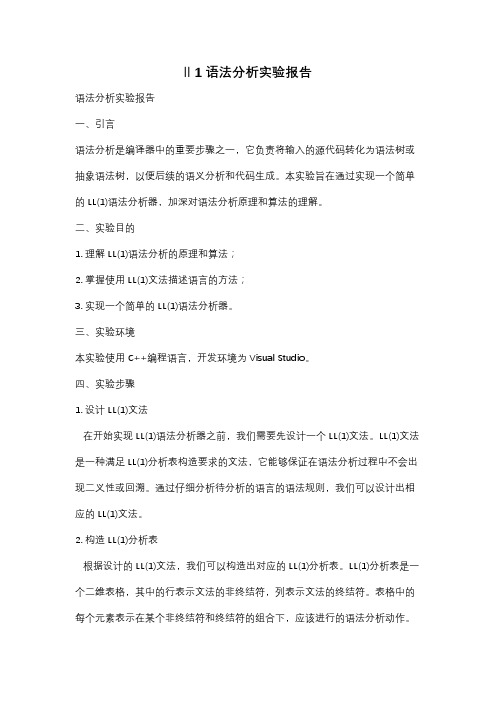
ll 1 语法分析实验报告语法分析实验报告一、引言语法分析是编译器中的重要步骤之一,它负责将输入的源代码转化为语法树或抽象语法树,以便后续的语义分析和代码生成。
本实验旨在通过实现一个简单的LL(1)语法分析器,加深对语法分析原理和算法的理解。
二、实验目的1. 理解LL(1)语法分析的原理和算法;2. 掌握使用LL(1)文法描述语言的方法;3. 实现一个简单的LL(1)语法分析器。
三、实验环境本实验使用C++编程语言,开发环境为Visual Studio。
四、实验步骤1. 设计LL(1)文法在开始实现LL(1)语法分析器之前,我们需要先设计一个LL(1)文法。
LL(1)文法是一种满足LL(1)分析表构造要求的文法,它能够保证在语法分析过程中不会出现二义性或回溯。
通过仔细分析待分析的语言的语法规则,我们可以设计出相应的LL(1)文法。
2. 构造LL(1)分析表根据设计的LL(1)文法,我们可以构造出对应的LL(1)分析表。
LL(1)分析表是一个二维表格,其中的行表示文法的非终结符,列表示文法的终结符。
表格中的每个元素表示在某个非终结符和终结符的组合下,应该进行的语法分析动作。
3. 实现LL(1)语法分析器基于构造的LL(1)分析表,我们可以开始实现LL(1)语法分析器。
分析器的主要工作是根据输入的源代码和LL(1)分析表进行分析,并输出语法树或抽象语法树。
五、实验结果与分析经过实验,我们成功实现了一个简单的LL(1)语法分析器,并对一些简单的语言进行了分析。
实验结果表明,我们设计的LL(1)文法和LL(1)分析表能够正确地进行语法分析,没有出现二义性或回溯。
六、实验总结通过本次实验,我们深入学习了LL(1)语法分析的原理和算法,并通过实现一个简单的LL(1)语法分析器加深了对其的理解。
实验过程中,我们发现LL(1)文法的设计和LL(1)分析表的构造是实现LL(1)语法分析器的关键。
同时,我们也意识到LL(1)语法分析器在处理复杂的语言时可能会面临一些困难,需要进一步的研究和优化。
编译原理实验 LL(1)分析
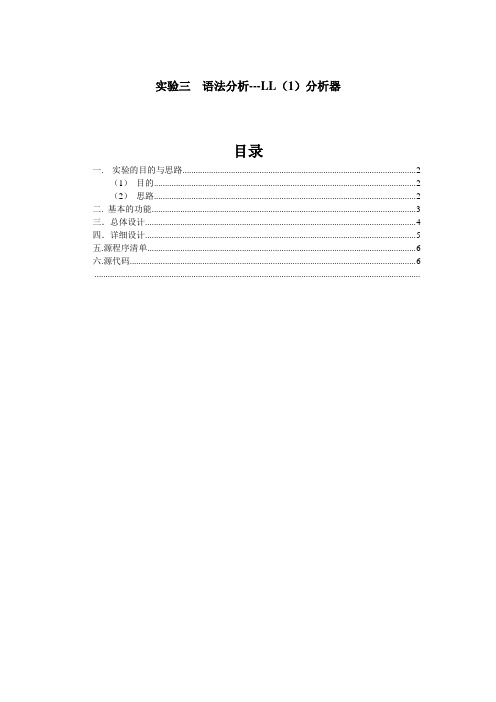
实验三语法分析---LL(1)分析器目录一. 实验的目的与思路 (2)(1)目的 (2)(2)思路 (2)二. 基本的功能 (3)三.总体设计 (4)四.详细设计 (5)五.源程序清单 (6)六.源代码 (6)....................................................................................................................................................一. 实验的目的与思路(1)目的1. 用程序的方法实现语法分析的LL(1)方法。
(2)思路本程序是采用的LL(1)方法进行的语法分析,而LL(1)的分析方法是属于自上而下的方法。
自上而下分析的基本思想是:对任意输入串,试图用一切可能的方法,从文法开始符号(根结点)出发,自上而下为输入串建立一棵语法树。
从推导的角度看,它是从文法的开始符号出发,反复使用各种产生式,寻找与输入串匹配的推导。
在输入之前必须要进行该文法是不是LL(1)文法的判断,然后再构造相应的LL(1)分析表来用预测分析方法进行语法分析,依据下面的文法及分析表来设计程序实现预测分析的分析过程。
1.文法G[E]:E --> E+T|TT --> T*F|FF --> (E) | i2.通过观察可知道该文法是一个左递归文法,要进行语法分析就必须消除左递归才能继续判断它是不是LL(1)文法,然后才能用预测分析方法进行语法分析。
3.消除左递归:E -->TMM --> +TM|uT --> FQQ --> *FQ|uF --> (E) | i4.在进行LL(1)文法的判断:(1.)各非终结符的FIRST集如下:FIRST(E)= FIRST(TM)= {(,i }FIRST(M)= { + }FIRST(T)= {(,i }FIRST(Q)= { * }FIRST(F)= { (,i }(2.)各非终结符的FOLLOW集如下:FOLLOW(E)= { ),# }FOLLOW(M)= { ),# }FOLLOW(T)= { + ,),# }FOLLOW(Q)= { + ,),# }FOLLOW(F)= { * ,+ ,),# }(3.)各产生式的SELECT集如下:SELECT(E→TM)={ ( ,i }SELECT(M→+TM)={+}SELECT(M→u)={ }, #}SELECT(T→FQ)={ ( ,i }SELECT(Q→*FQ)={ *}SELECT(Q→u)={ +,), # }SELECT(F→(E))={ ( )SELECT(F→i)={ i }因为:SELECT(M→+TM)∩SELECT(M→u)=ФSELECT(Q→*FQ)∩SELECT(Q→u)=ФSELECT(F→(E))∩SELECT(F→i)=Ф因此可以判断该文法是一个LL(1)文法可以构造预测分析表。
LL(1) 语法分析实验 (4学时)——学实验报告

大学实验报告
No. 2
课程编译原理成绩教师签章
实验名称:LL(1) 语法分析实验(4学时)
一、实验目的:
1. 了解LL(1)语法分析是如何根据语法规则逐一分析词法分析所得到的单词,检查语法错误,即掌握语法分析过程。
2. 掌握LL(1)语法分析器的设计与调试
二、实验内容:
文法:E→TE’,E’→+TE’|ε,T→FT’,T’→*FT’|ε,F→(E) | i
针对上述文法,编写一个LL(1)语法分析程序:
1. 输入:诸如i+i*i 的字符串,以#结束。
2. 处理:基于分析表进行LL(1)语法分析,判断其是否符合文法。
3. 输出:串是否合法。
三、实验要求:
1. 在编程前,根据上述文法建立对应的、正确的预测分析表。
2. 设计恰当的数据结构存储预测分析表。
3. 任选C/C++/Java中的一种作为编程语言,要求所编程序结构清晰。
四、实验环境:
系统要求:WindowsXP系统
内存:256M以上
软件支持:Microsoft Visual C++6.0
开发语言:C++
五、实验分析:
1.通过文法:E→TE’,E’→+TE’|ε,T→FT’,T’→*FT’|ε,F→(E) | i 产生
六、实验过程:
七、实验结论:。
语法分析器实验报告

语法分析器的设计实验报告一、实验内容语法分析程序用LL(1)语法分析方式。
第一输入概念好的文法书写文件(所用的文法能够用LL(1)分析),先求出所输入的文法的每一个非终结符是不是能推出空,再别离计算非终结符号的FIRST 集合,每一个非终结符号的FOLLOW集合,和每一个规那么的SELECT集合,并判定任意一个非终结符号的任意两个规那么的SELECT集的交集是不是都为空,若是是,那么输入文法符合LL(1)文法,能够进行分析。
关于文法:G[E]:E->E+T|TT->T*F|FF->i|(E)分析句子i+i*i是不是符合文法。
二、大体思想一、语法分析器实现语法分析是编译进程的核心部份,它的要紧任务是依照程序的语法规那么,从由词法分析输出的源程序符号串中识别出各类语法成份,同时进行词法检查,为语义分析和代码生成作预备。
那个地址采纳自顶向下的LL(1)分析方式。
语法分析程序的流程图如图5-4所示。
语法分析程序流程图该程序可分为如下几步:(1)读入文法(2)判定正误(3)假设无误,判定是不是为LL(1)文法(4)假设是,构造分析表;(5)由句型判别算法判定输入符号串是为该文法的句型。
三、核心思想该分析程序有15部份组成:(1)第一概念各类需要用到的常量和变量;(2)判定一个字符是不是在指定字符串中;(3)读入一个文法;(4)将单个符号或符号串并入另一符号串;(5)求所有能直接推出&的符号;(6)求某一符号可否推出‘& ’;(7)判定读入的文法是不是正确;(8)求单个符号的FIRST;(9)求各产生式右部的FIRST;(10)求各产生式左部的FOLLOW;(11)判定读入文法是不是为一个LL(1)文法;(12)构造分析表M;(13)句型判别算法;(14)一个用户挪用函数;(15)主函数;下面是其中几部份程序段的算法思想:1、求能推出空的非终结符集Ⅰ、实例中求直接推出空的empty集的算法描述如下:void emp(char c){ 参数c为空符号char temp[10];概念临时数组int i;for(i=0;i<=count-1;i++)从文法的第一个产生式开始查找{if 产生式右部第一个符号是空符号而且右部长度为1,then将该条产生式左部符号保留在临时数组temp中将临时数组中的元素归并到记录可推出&符号的数组empty中。
LL(1)语法分析实验报告
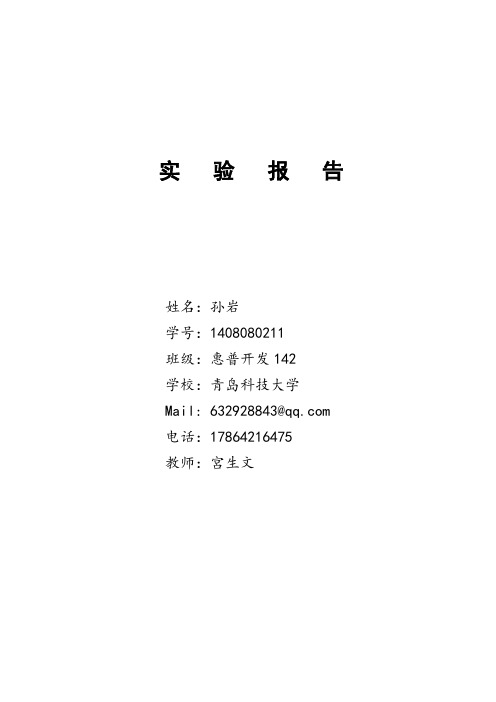
实验报告姓名:***学号:**********班级:惠普开发142学校:青岛科技大学Mail:****************电话:178****6475教师:宮生文实验报告:实验名称:LL(1)语法分析实验目的和要求编制一个能识别由词法分析给出的单词符号序列是否是给定文法的正确句子(程序),输出对输入符号串的分析过程。
实验内容和步骤:一、实验内容对于这个实验,总共用了三个函数,即主函数、输出分析栈函数、输出剩余串函数。
在主函数中,还要构造预测分析表。
二、实验步骤1、基于实验的内容,构造程序所需的模块2、根据已建构的模块,写出各个模块的相应程序代码3、在主函数中调用模块来完成所要得到的效果在本程序中,首先使用了结构体类型定义来定义产生式,用字符串数组存放分析栈、剩余串、终结符和非终结符,用二维数组存放预测分析表,利用指针对栈中数据进行读取。
在本程序中,总共用了三个函数,即主函数、输出分析栈函数、输出剩余串函数。
在主函数中,还要构造预测分析表,对输入的字符串进行分析,调用另外两个函数。
实验代码如下:#include<stdio.h>#include<stdlib.h>#include<string.h>#include<dos.h>char A[20];/*分析栈*/char B[20];/*剩余串*/char v1[20]={'i','+','*','(',')','#'};/*终结符*/char v2[20]={'E','G','T','S','F'};/*非终结符*/int j=0,b=0,top=0,l;/*L为输入串长度*/typedef struct type/*产生式类型定义*/{char origin;/*大写字符*/char array[5];/*产生式右边字符*/int length;/*字符个数*/}type;type e,t,g,g1,s,s1,f,f1;/*结构体变量*/type C[10][10];/*预测分析表*/void print()/*输出分析栈*/{int a;/*指针*/for(a=0;a<=top+1;a++)printf("%c",A[a]);printf("\t\t");}/*print*/void print1()/*输出剩余串*/{int j;for(j=0;j<b;j++)/*输出对齐符*/printf(" ");for(j=b;j<=l;j++)printf("%c",B[j]);printf("\t\t\t");}/*print1*/void main(){int m,n,k=0,flag=0,finish=0;char ch,x;type cha;/*用来接受C[m][n]*//*把文法产生式赋值结构体*/e.origin='E';strcpy(e.array,"TG");e.length=2;t.origin='T';strcpy(t.array,"FS");t.length=2;g.origin='G';strcpy(g.array,"+TG");g.length=3;g1.origin='G';g1.array[0]='^';g1.length=1;s.origin='S';strcpy(s.array,"*FS");s.length=3;s1.origin='S';s1.array[0]='^';s1.length=1;f.origin='F';strcpy(f.array,"(E)");f.length=3;f1.origin='F';f1.array[0]='i';f1.length=1;for(m=0;m<=4;m++)/*初始化分析表*/for(n=0;n<=5;n++)C[m][n].origin='N';/*全部赋为空*//*填充分析表*/C[0][0]=e;C[0][3]=e;C[1][1]=g;C[1][4]=g1;C[1][5]=g1;C[2][0]=t;C[2][3]=t;C[3][1]=s1;C[3][2]=s;C[3][4]=C[3][5]=s1;C[4][0]=f1;C[4][3]=f;printf("提示:本程序只能对由'i','+','*','(',')'构成的以'#'结束的字符串进行分析,\n"); printf("请输入要分析的字符串:");do/*读入分析串*/{scanf("%c",&ch);if ((ch!='i') &&(ch!='+') &&(ch!='*')&&(ch!='(')&&(ch!=')')&&(ch!='#')){printf("输入串中有非法字符\n");exit(1);}B[j]=ch;j++;}while(ch!='#');l=j;/*分析串长度*/ch=B[0];/*当前分析字符*/A[top]='#'; A[++top]='E';/*'#','E'进栈*/printf("步骤\t\t分析栈\t\t剩余字符\t\t所用产生式\n");do{x=A[top--];/*x为当前栈顶字符*/printf("%d",k++);printf("\t\t");for(j=0;j<=5;j++)/*判断是否为终结符*/if(x==v1[j]){flag=1;break;}if(flag==1)/*如果是终结符*/{if(x=='#'){finish=1;/*结束标记*/printf("acc!\n");/*接受*/getchar();getchar();exit(1);}/*if*/if(x==ch){print();print1();printf("%c匹配\n",ch);ch=B[++b];/*下一个输入字符*/flag=0;/*恢复标记*/}/*if*/else/*出错处理*/{print();print1();printf("%c出错\n",ch);/*输出出错终结符*/exit(1);}/*else*/}/*if*/else/*非终结符处理*/{for(j=0;j<=4;j++)if(x==v2[j]){m=j;/*行号*/break;}for(j=0;j<=5;j++)if(ch==v1[j]){n=j;/*列号*/break;}cha=C[m][n];if(cha.origin!='N')/*判断是否为空*/{print();print1();printf("%c-",cha.origin);/*输出产生式*/for(j=0;j<cha.length;j++)printf("%c",cha.array[j]);printf("\n");for(j=(cha.length-1);j>=0;j--)/*产生式逆序入栈*/A[++top]=cha.array[j];if(A[top]=='^')/*为空则不进栈*/top--;}/*if*/else/*出错处理*/{print();print1();printf("%c出错\n",x);/*输出出错非终结符*/exit(1);}/*else*/}/*else*/}while(finish==0);}/*main*/三、实验过程记录:实验截图:当输入内容不匹配或输入内容非法时要退出程序,此时若不关闭已经打开的文件可能导致文件内容受到破坏;解决方法是给error()函数设置一个文件指针变量参数FILE* fp,在退出程序之前通过fp关闭文件四、实验总结:通过本次实验我锻炼了自己的上机操作能力及编程能力,并对理论知识有了进一步的了解。
- 1、下载文档前请自行甄别文档内容的完整性,平台不提供额外的编辑、内容补充、找答案等附加服务。
- 2、"仅部分预览"的文档,不可在线预览部分如存在完整性等问题,可反馈申请退款(可完整预览的文档不适用该条件!)。
- 3、如文档侵犯您的权益,请联系客服反馈,我们会尽快为您处理(人工客服工作时间:9:00-18:30)。
《LL(1)分析器的构造》实验报告一、实验名称LL(1)分析器的构造二、实验目的设计、编制、调试一个LL(1)语法分析器,利用语法分析器对符号串的识别,加深对语法分析原理的理解。
三、实验内容和要求设计并实现一个LL(1)语法分析器,实现对算术文法:G[E]:E->E+T|TT->T*F|FF->(E)|i所定义的符号串进行识别,例如符号串i+i*i为文法所定义的句子,符号串ii+++*i+不是文法所定义的句子。
实验要求:1、检测左递归,如果有则进行消除;2、求解FIRST集和FOLLOW集;3、构建LL(1)分析表;4、构建LL分析程序,对于用户输入的句子,能够利用所构造的分析程序进行分析,并显示出分析过程。
四、主要仪器设备硬件:微型计算机。
软件: Code blocks(也可以是其它集成开发环境)。
五、实验过程描述1、程序主要框架程序中编写了以下函数,各个函数实现的作用如下:void input_grammer(string *G);.Xn的FIRST集string** create_table(string *P,string U,string u,int n,int t,int k,string* first);ppend(1,a) U=u=" ";mpty();n++){ U[n]=G[n][0];}ength();j++){if(G[i][j])==string::npos&&(G[i][j])==string::npos)if(G[i][j]!='|'&&G[i][j]!='^')ength();j++){P[k][0]=U[i];P[k][1]=':';P[k][2]=':';P[k][3]='=';/* if(G[i][j]=='('){ j++;flag=1;for(temp=j;G[i][temp]!=')';temp++);C=G[i][temp+1];ppend(1,U[i]);GG[m].append("::=");if('|')!=string::npos) GG[m].append("("+beta+")");else GG[m].append(beta);while(C)!=string::npos){C++;}GG[m].append(1,C);m++;GG[m].append(1,C);GG[m].append("::=");if('|')!=string::npos) GG[m].append("("+arfa+")");else GG[m].append(arfa);GG[m].append(1,C);GG[m].append("|^");m++;C++;}ind('^')==string::npos) first[r].append(1,'^');ind(a)==string::npos)ppend(1,a);break;.Yk{s=(P[i][j]);ind(a)==string::npos)ppend(1,a);}}if(!empty[s]) break;ind('^')==string::npos)first[r].append(1,'^');.Yk都能推导到空,则加入空符号}}}return first;}string FIRST(string U,string u,string* first,string s).Xn的FIRST集{int i,j,r;char a;string fir;for(i=0;i<();i++){if(s[i]=='^') (1,'^');if(s[i])!=string::npos&&(s[i])==string::npos){ (1,s[i]);break;}ind('^')==string::npos) break;.的规则右部各符号压栈i++;}r--;}}else{cout<<"error\n";cout<<ss<<"不是该文法的句子\n";break;}}step++;}if(flag) cout<<endl<<ss<<"是该文法的句子\n";}int main(){int i,j;string *G=new string[50];//文法Gstring *P=new string[50];//产生式集合Pstring U,u;//文法G非终结符集合U,终结符集合uint n,t,k;//非终结符、终结符个数,产生式数string *GG=new string[50];//消除左递归后的文法GGstring *PP=new string[50];//文法GG的产生式集合PPstring UU,uu;//文法GG非终结符集合U,终结符集合uint nn,tt,kk;//消除左递归后的非终结符、终结符个数,产生式数string** table;//分析表cout<<" 欢迎使用LL(1)语法分析器!\n\n\n";cout<<"请输入文法(同一左部的规则在同一行输入,例如:E::=E+T|T;用^表示空串)\n"; input_grammer(G);preprocess(G,P,U,u,n,t,k);cout<<"\n该文法有"<<n<<"个非终结符:\n";for(i=0;i<n;i++) cout<<U[i];cout<<endl;cout<<"该文法有"<<t<<"个终结符:\n";for(i=0;i<t;i++) cout<<u[i];cout<<"\n\n 左递归检测与消除\n\n";if(eliminate_1(G,P,U,GG))preprocess(GG,PP,UU,uu,nn,tt,kk);cout<<"该文法存在左递归!\n\n消除左递归后的文法:\n\n"; for(i=0;i<nn;i++) cout<<GG[i]<<endl;cout<<endl;cout<<"新文法有"<<nn<<"个非终结符:\n";for(i=0;i<nn;i++) cout<<UU[i];cout<<endl;cout<<"新文法有"<<tt<<"个终结符:\n";for(i=0;i<tt;i++) cout<<uu[i];cout<<endl;//cout<<"新文法有"<<kk<<"个产生式:\n";//for(i=0;i<kk;i++) cout<<PP[i]<<endl;}else{cout<<"该文法不存在左递归\n";GG=G;PP=P;UU=U;uu=u;nn=n;tt=t;kk=k;}cout<<" 求解FIRST集\n\n";int *empty=ifempty(PP,UU,kk,nn);string* first=FIRST_X(PP,UU,uu,empty,kk,nn);for(i=0;i<nn;i++)cout<<"FIRST("<<UU[i]<<"): "<<first[i]<<endl;cout<<" 求解FOLLOW集\n\n";for(i=0;i<nn;i++)cout<<"FOLLOW("<<UU[i]<<"): "<<FOLLOW[i]<<endl;cout<<"\n\n 构造文法分析表\n\n"; table=create_table(PP,UU,uu,nn,tt,kk,first);cout<<" ";for(i=0;i<tt;i++) cout<<" "<<uu[i]<<" ";cout<<"# "<<endl;for( i=0;i<nn;i++)cout<<UU[i]<<" ";for(j=0;j<t+1;j++)cout<<table[i][j];cout<<endl;}cout<<"\n\n 分析符号串\n\n"; string s;cout<<"请输入要分析的符号串\n";cin>>s;analyse(table,UU,uu,tt,s);return 0;}3、程序演示结果(1)输入文法(2)消除左递归(3)求解FIRST和FOLLOW集(4)构造分析表(5)分析符号串匹配成功的情况:匹配失败的情况五、思考和体会1、编写的LL(1)语法分析器应该具有智能性,可以由用户输入任意文法,不需要指定终结符个数和非终结符个数。
而是由分析器自己预处理得到例如:2、语法分析器应该能够消除同一左部的规则含有多个左递归的情况。
